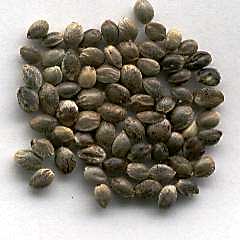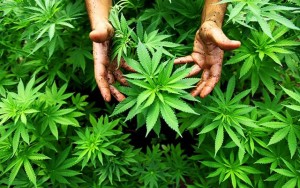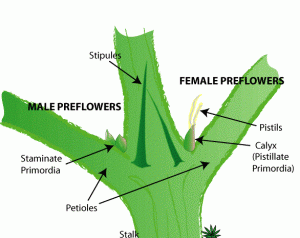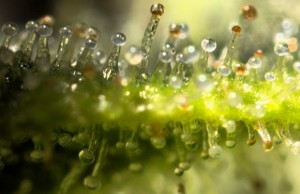
Many growers use high-phosphorus and low-nitrogen fertilizers during the flowering cycle and when producing cannabis seeds.
Even though some growers use different fertilizing methods when producing seeds; it is best to provide complete, balanced, and organic-based fertilizers and soil mixes to produce the healthiest cannabis seeds as possible.
When seeds are being created their genetic material is inherited from both parents, which includes 10 chromosomes from the mother or pistillate parent and 10 from the male staminate parent.
Their genetic code is written along the length of chromosome strands and each gene has its specific location as well as length.
Phenotype
Plant phenotype is an observable, quantifiable representation of a given trait that the plant exudes. It is anything that you can measure, categorize, or observe in a plant so, for example, a plant’s height is a phenotype that can be a small plant phenotype, medium phenotype, or a large phenotype.
Another common phenotype is the color of female cannabis flowers, as well as a pink and white pistillate, is a phenotype. All phenotypes are the observable result of genes acting within the cells of the plant. A single gene can control either one trait (monogenic traits) or control more than one trait (polygenic traits).
Genotype

Genotype is a way of describing the actual genetic condition that results in the phenotype. Some genetic constitution or makeup of a plant will not always be expressed so this is termed as latent and will only show when under certain environmental conditions.
A good example of this is that some plants have green leaves and others will turn purple under cold environmental conditions, while other plants’ leaves will remain green even when under cold environmental conditions.
These different gene versions are called alleles. Both of these plants have the genes for green leaves through one plant developed an altered phenotype (the purple leaf) that responds to environmental factors. This is caused by an interaction of the genetics of a certain plant concerning its trait (genotype) and the environment.
A simple way to think of this concept is:
Phenotype = Genotype + Environment
This concept is not always genuine but is more accurate than some are the result of an interaction of the plant’s genotype with the environment. The phenotype is the physical characteristics of the plant while the genotype is a symbol used to represent that trait.
There are always two (2) alleles, or versions, of every gene that is responsible for a plant’s stature, height, etc. for cannabis seeds. Many times master cannabis growers will case the symbol for the genotype on the first letter of the recessive expression of a trait.
| Phenotypes | Genotypes |
| Tall | SS |
| Medium | Ss |
| Short | ss |
Homozygous and Heterozygous
Homozygous and heterozygous are terms that are used to describe the genotypic condition of a plant about the likeness of the alleles for a given trait in cannabis seeds.
If a plant is homozygous for a given trait, then it has two (2) copies of the same allele as “homo” means the same. If a plant is heterozygous then has two (2) different alleles for a given trait since “hetero” means different.
Homozygous

A plant is said to be homozygous for a particular gene when identical alleles are present on both homologous chromosomes. The plant is called a homozygote and true breeding is always homozygous for the traits that are to be held constant.
A cannabis plant that is homozygous-dominant for a particular trait carries two (2) copies of the allele that codes for the dominant trait. This allele, often called the “dominant allele” is normally represented by a capital letter (such as “P” for the dominant allele producing purple leaves in plants).
When a plant is homozygous-dominant for a particular trait the genotype is represented by a doubling of the symbol for that trait, such as “PP“. An individual that is homozygous recessive for a particular trait carries two (2) copies of the allele that codes for the recessive trait for cannabis seeds.
This allele, often called the “recessive allele” is usually represented by the lowercase form of the letter used for the corresponding dominant trait (such as, concerning the example above, “p” for the recessive allele producing green leaves on plants). The genotype of an organism that is homozygous recessive for a particular trait is represented by a doubling of the appropriate letter, such as “pp”.
Heterozygous
A diploid plant is heterozygous at a gene locus when its cells contain two (2) different alleles of a gene. Heterozygous genotypes are represented by a capital letter (representing the dominant allele) and a lowercase letter (representing the recessive allele) such as “Rr” or “Ss”.
The capital letter is usually written first. If the trait in question is determined by simple (complete) dominance a heterozygote will express only the trait coded by the dominant allele and the trait coded by the recessive allele will not be present. In more complex dominance schemes the results of heterozygosity can be more complex in cannabis seeds.
Recessive
 Recessive is an intra-allelic interaction such that an allele of one (1) parent is masked by the presence of an allele from the other parent plant in the expression of a given trait in the progeny.
Recessive is an intra-allelic interaction such that an allele of one (1) parent is masked by the presence of an allele from the other parent plant in the expression of a given trait in the progeny.
The recessive trait that is not shown in the first generation of progeny (F1) will re-appear if siblings are mated with the second generation (F2) progeny will result in 25 percent statistically of the plants showing the recessive condition in cannabis seeds.
Dominant
Dominant is an intra-allelic interaction such that the presence of an allele from another parent plant in the expression of a given trait in the progeny for cannabis seeds. Only the dominant trait is shown in the first generation of offspring. In the second generation (F2) 75 percent statistically will also show the dominant condition for their cannabis seeds.
Let us know what you think.




Responses